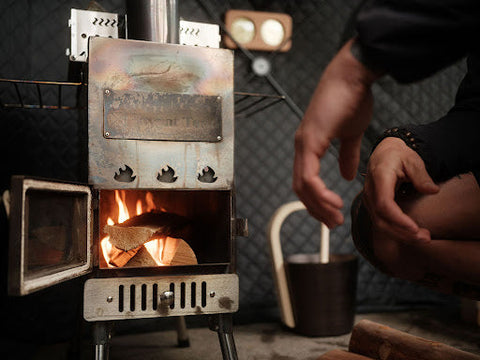Saunas aren't just about relaxation anymore; they are game-changers in today's health routines, helping with everything from muscle recovery to helping us live longer lives.
Wet and dry saunas, each with their unique perks, are making waves in wellness circles for their robust benefits. But what's the real difference between a dry vs. wet sauna, and how do you know which method is right for you?
Let's dive in and unpack the core differences between a wet sauna vs. dry sauna, so you can find your ideal sweat session. Plus, discover how Sweat Tent’s home sauna tent brings the best of both worlds right to your doorstep, ready whenever you are.

What is a Wet Sauna?
A wet sauna is a variation of the traditional sauna experience, incorporating both dry heat and steam. At its essence, a wet sauna uses a heat source, usually hot rocks or a closed stove, similar to a dry sauna.
In a wet sauna, the atmosphere is heavy with moisture, with humidity levels often soaring above 50%. This high humidity makes sweat evaporate less efficiently. As a result, steam saunas can feel hotter and may put more pressure on your heart and circulation, even if the temperature reads the same as in a dry sauna.

Are Wet Saunas and Steam Rooms the Same Thing?
While similar and often used interchangeably, wet saunas and steam rooms are not the same.
Although both provide a moist environment, their heating methods–and the intensity of the heat differ. Wet saunas derive their initial heat from a stove or hot rocks and introduce moisture by pouring water over these heat sources, which can reach up to 220° F. Steam rooms' heat intensity typically rests between 110 and 120°F.
On the other hand, steam rooms use a steam generator filled with boiling water to create a consistently steamy environment. The fundamental difference lies in their heat sources and the way moisture is introduced into the space.
RELATED: How Long Should You Stay In a Sauna for Optimal Benefits?

What is a Dry Sauna?
A dry sauna, traditionally rooted in Finnish culture, is a special chamber or cabin that delivers heat to the body without increasing the ambient humidity. Traditionally constructed using wood, like cedar or hemlock, these saunas produce their characteristic dry heat through a stove, typically electric or wood-fired, which heats a collection of rocks. As the rocks get hot, they radiate heat throughout the sauna room. The temperature can range from 160°F to 200°F (70°C to 90°C) with a low humidity level, usually between 5-20%.
Unlike its wet counterpart, water isn't poured over the rocks in a dry sauna, ensuring the humidity remains minimal. The dry heat environment promotes sweating, which is believed to have several health benefits, from relaxation to potential cardiovascular improvements. The design ensures that the interior remains relatively moisture-free, allowing users to experience the benefits of heat without a steamy environment.

Are There Different Benefits of a Dry Sauna vs. Wet Sauna?
Saunas, both dry and wet, have long been associated with relaxation and wellness. However, each offers distinct experiences and benefits.
Shared Benefits of Wet and Dry Saunas
Relaxation: Regardless of type, saunas promote relaxation. The heat helps soothe muscles, reduce tension, and alleviate stress.
Detoxification: Saunas help support detoxification through sweating. As you sweat, your body expels toxins, which can lead to a feeling of rejuvenation.
Improved Circulation: The heat from saunas can stimulate blood flow, leading to better circulation. Improved blood flow can aid in muscle recovery and reduce inflammation.

Dry Sauna Benefits
Lower Humidity: Dry saunas have a humidity level of around 10-20%, making the experience less stifling for some. This allows many users to tolerate higher temperatures, intensifying the detoxification process.
Flexibility in Humidity Control: In some cultures, like Finland, users occasionally introduce moisture (through practices like "löyly") by sprinkling water on the heated rocks, providing a customizable experience.
Respiratory Relief: For those sensitive to moisture or with specific respiratory conditions like asthma, dry saunas might offer a more comfortable environment, reducing potential irritation caused by excessive humidity.
Wet Sauna Benefits
Skin Hydration: The high humidity in wet saunas keeps the skin moist, potentially aiding in better hydration and a radiant complexion.
Respiratory Benefits: Steam can help open airways, making breathing easier. It can be especially beneficial for those with congestion or sinus issues. Pair this steamy session with therapeutic-grade eucalyptus essential oil for a rejuvenating, spa-like sauna experience.
Perceived Intensity: The high humidity can make the sauna feel hotter, even at lower temperatures. This can lead to a more intense sweating session in a shorter amount of time, potentially amplifying detoxification benefits.

Dry vs. Wet Sauna: Which is Best For You?
Dry saunas offer a controlled, low-humidity environment, providing a soothing escape for those who lean towards a drier heat experience. On the other hand, wet saunas amplify the essence of a steamy retreat, promising intense sweating sessions amid high humidity.
With Sweat Tent’s home sauna tent, there's no need to choose. 100% portable and purely wood-fired, Sweat Tent grants you the versatility of both sauna experiences. Its potent, portable, and affordable design lets you indulge in a sauna session anytime, anywhere.

Whether you're after the intense perspiration of a wet sauna or the calm, humidity-regulated ambiance of a dry one, both promise relaxation and an uplift in overall well-being. Immerse yourself in the definitive sauna experience with Sweat Tent’s home sauna tent and sauna accessories—elevate your journey to peak health and wellness!
For a deeper dive into sauna benefits and guidelines, explore the Sweat Tent blog. Catch a glimpse of Sweat Tent in action on Instagram (@sweattents), or share your moments with us using #sweattent!
Medical disclaimer: This post is intended for informational purposes only and is not a substitute for professional medical advice. Please consult with your doctor before adding sauna bathing to your health and wellness routine.








